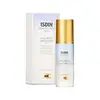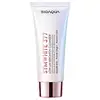What's inside
What's inside
 Key Ingredients
Key Ingredients

 Benefits
Benefits

 Concerns
Concerns

 Ingredients Side-by-side
Ingredients Side-by-side

Water
Skin ConditioningDimethicone
EmollientPropanediol
SolventGlycerin
Humectant1,2-Hexanediol
Skin ConditioningSodium Acrylates Copolymer
Dimethicone Crosspolymer
Emulsion StabilisingButylene Glycol
HumectantPseudoalteromonas Ferment Extract
HumectantGlycereth-26
HumectantLecithin
EmollientMaltodextrin
AbsorbentSodium Benzoate
MaskingPentylene Glycol
Skin ConditioningLens Esculenta Seed Extract
Skin ProtectingParfum
MaskingDisodium EDTA
Hydrolyzed Hyaluronic Acid
HumectantSodium Hyaluronate
HumectantXanthan Gum
EmulsifyingCitric Acid
BufferingBiosaccharide Gum-1
HumectantCarbomer
Emulsion StabilisingPolysorbate 20
EmulsifyingSodium Lactate
BufferingSodium Salicylate
PreservativeSalicylic Acid
MaskingPalmitoyl Tripeptide-1
Skin ConditioningPalmitoyl Tetrapeptide-7
Skin ConditioningWater, Dimethicone, Propanediol, Glycerin, 1,2-Hexanediol, Sodium Acrylates Copolymer, Dimethicone Crosspolymer, Butylene Glycol, Pseudoalteromonas Ferment Extract, Glycereth-26, Lecithin, Maltodextrin, Sodium Benzoate, Pentylene Glycol, Lens Esculenta Seed Extract, Parfum, Disodium EDTA, Hydrolyzed Hyaluronic Acid, Sodium Hyaluronate, Xanthan Gum, Citric Acid, Biosaccharide Gum-1, Carbomer, Polysorbate 20, Sodium Lactate, Sodium Salicylate, Salicylic Acid, Palmitoyl Tripeptide-1, Palmitoyl Tetrapeptide-7
Water
Skin ConditioningSodium Lauroyl Isethionate
CleansingCocamidopropyl Betaine
CleansingSodium Lauroyl Sarcosinate
CleansingNiacinamide
SmoothingGlycol Distearate
EmollientAcrylates Copolymer
Cocamide DEA
EmulsifyingSodium Chloride
MaskingPhenylethyl Resorcinol
AntioxidantDisodium EDTA
Hydroxyacetophenone
AntioxidantCentella Asiatica Extract
CleansingCaprylhydroxamic Acid
Ethylhexylglycerin
Skin ConditioningPotassium Hydroxide
BufferingGlyceryl Caprylate
EmollientCeramide Ns
Skin ConditioningCeramide NP
Skin ConditioningCeramide Ng
Skin ConditioningCeramide Eos
Skin ConditioningCeramide EOP
Skin ConditioningCeramide As
Skin ConditioningCeramide AP
Skin ConditioningTranexamic Acid
AstringentBifida Ferment Filtrate
Skin ConditioningHydrolyzed Rhodophyceae Extract
Dextran
Sophora Flavescens Root Extract
AntioxidantPortulaca Oleracea Extract
Skin ConditioningHexapeptide-8
Skin ConditioningMica
Cosmetic ColorantOligopeptide-1
Skin ConditioningCarnosine
Skin ConditioningHydrolyzed Hyaluronic Acid
HumectantHyaluronic Acid
HumectantSodium Hyaluronate
HumectantWater, Sodium Lauroyl Isethionate, Cocamidopropyl Betaine, Sodium Lauroyl Sarcosinate, Niacinamide, Glycol Distearate, Acrylates Copolymer, Cocamide DEA, Sodium Chloride, Phenylethyl Resorcinol, Disodium EDTA, Hydroxyacetophenone, Centella Asiatica Extract, Caprylhydroxamic Acid, Ethylhexylglycerin, Potassium Hydroxide, Glyceryl Caprylate, Ceramide Ns, Ceramide NP, Ceramide Ng, Ceramide Eos, Ceramide EOP, Ceramide As, Ceramide AP, Tranexamic Acid, Bifida Ferment Filtrate, Hydrolyzed Rhodophyceae Extract, Dextran, Sophora Flavescens Root Extract, Portulaca Oleracea Extract, Hexapeptide-8, Mica, Oligopeptide-1, Carnosine, Hydrolyzed Hyaluronic Acid, Hyaluronic Acid, Sodium Hyaluronate
Ingredients Explained
These ingredients are found in both products.
Ingredients higher up in an ingredient list are typically present in a larger amount.
Disodium EDTA plays a role in making products more stable by aiding other preservatives.
It is a chelating agent, meaning it neutralizes metal ions that may be found in a product.
Disodium EDTA is a salt of edetic acid and is found to be safe in cosmetic ingredients.
Learn more about Disodium EDTAHydrolyzed Hyaluronic Acid is a form of hyaluronic acid. It is created by the hydrolysis of hyaluronic acid with a high molecular weight. Once created, Hydrolyzed Hyaluronic Acid has a low molecular weight.
Low molecular weight HA has been shown to hydrate and increase elasticity of the skin. Increasing elasticity is also associated with reduction of wrinkle depth.
One study found topical low molecular weight hyaluronic acid may be considered for the treatment of rosacea in the adult population. However, we always recommend speaking with a professional about your skin concerns.
Hyaluronic acids are a humectant. This means they draw moisture from the air. Hyaluronic acids help moisturize, soothe, and protect the skin.
Read more about other common forms of hyaluronic acid:
Learn more about Hydrolyzed Hyaluronic AcidSodium Hyaluronate is hyaluronic acid's salt form. It is commonly derived from the sodium salt of hyaluronic acid.
Like hyaluronic acid, it is great at holding water and acts as a humectant. This makes it a great skin hydrating ingredient.
Sodium Hyaluronate is naturally occurring in our bodies and is mostly found in eye fluid and joints.
These are some other common types of Hyaluronic Acid:
Learn more about Sodium HyaluronateWater. It's the most common cosmetic ingredient of all. You'll usually see it at the top of ingredient lists, meaning that it makes up the largest part of the product.
So why is it so popular? Water most often acts as a solvent - this means that it helps dissolve other ingredients into the formulation.
You'll also recognize water as that liquid we all need to stay alive. If you see this, drink a glass of water. Stay hydrated!
Learn more about Water